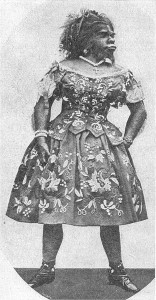By Helen King (Regular Contributor)
In February 2013 there was a big day for the ‘bearded lady’: Julia Pastrana’s body was repatriated to her native Mexico and buried, her coffin covered with white roses. Julia, ‘the world’s ugliest woman’, suffered from excessive hair growth on her face. She was exhibited at freak shows by her impresario husband in the 1850s and, after her death in 1860, he went on travelling with her embalmed body, displayed so that audiences could now gaze at her without the embarrassment of her returning their stares. Rebecca Stern has listed the many parallels between Julia and the character Marian Halcombe in Wilkie Collins’ Woman in White, which was serialised in 1859-60. For example, we are told that Halcombe’s ‘complexion was almost swarthy, and the dark down on her upper lip was almost a moustache’, and that the viewer is ‘almost repelled by the masculine form and masculine look of the features in which the perfectly shaped figure ended’.
Julia was by no means the first such woman to be displayed. In the Renaissance, the three Gonzales ‘hairy girls’ were moved around the courts of Europe during the sixteenth century, like living items in a cabinet of curiosities. But it was in the mid-nineteenth century that the ‘bearded lady’ became a staple of the live freak show. The rise of the railway and the steam ship in the 1830s enabled such shows to take off, with performers being able to travel not just within one country, but also between nations. Nadja Durbach argued that the peak of their popularity came at a time of ‘modern and imperial self-fashioning’. Why ‘modern’? Because, scholars argue, the display of the ‘weird’ is part of modernity’s attempts to restrict the possibilities for individual variation. Not just the paying public, but also medical professionals, were interested in these variations.
While some such ‘women’ may have been men dressed in women’s clothing, many were not. Those displayed included people of uncertain sex – such as Gottlieb Göttlich, who travelled over Europe as medical experts failed to decide on the ‘true sex’ – as well women with various hormonal or genetic conditions who grew beards or were hairy all over. The ‘bearded lady’ was often shown smartly dressed, looking like a respectable woman of the time. This made the beard even more of a shock. Those with hair all over were shown in skimpy clothing and displayed as the ‘missing link’ with the animal kingdom; for example, both photographs and posters survive showing a woman who was exhibited from 1883 as ‘Krao’, and the posters were drawn to make her more hairy than she really was.
Were these people exploited, tragic figures, or were they in control and finding a way to make a living? Was this a career – or a form of slavery? Krao’s display coincided with the move for women’s rights in education and politics, making the ‘bearded lady’ a particularly worrying figure. In one cartoon of the period, a suffragette asks the bearded lady on display in a shop window ‘How did you manage it?’ The bearded lady has her travelling bag beside her; this shows that, in some ways, it is she rather than the suffragette who has the greater freedom.
To find out more:
Nadja Durbach, Spectacle of Deformity. Freak Shows and Modern British Culture, Berkeley, Los Angeles and London: University of California Press, 2010.
Rebecca Stern, ‘Our bear women, ourselves. Affiliating with Julia Pastrana’ in Marlene Tromp (ed.), Victorian Freaks. The Social Context of Freakery in Britain, Columbus, OH: Ohio State University Press, 2008, 200-233.
Merry Wiesner-Hanks, The Marvellous Hairy Girls, New Haven and London: Yale University Press, 2009.
This post first appeared at Wonders & Marvels on 10 March 2013. Since then, I’ve extended my interest in the disruptive potential of the beard with a piece for The Conversation on the Conchita Wurst phenomenon.

